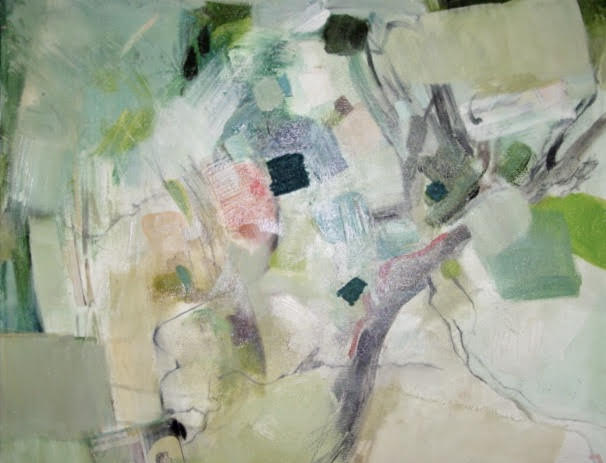When exhibiting abstract oils, I’ve encountered questions by folks who prefer realistic work: “Why do you paint abstracts?” “What is it supposed to be anyway?” “What does it mean?”
I usually answer something like, “How much time do you have?” for such questions are not easily answered. A certain seriousness by the questioner is requisite. If genuine interest is evident and the questioner is not in a hurry, I begin by explaining that abstraction uses all the same design elements of any realistic painting: line, form, shape, value, color, texture, contrast, movement. I point out that the abstract artist is attempting to express her feelings, thoughts, ideas without representation of material objects. I go on to explain that abstract painters such as Kandinsky, Picasso, Mondrian, even Rothko, began with realistic drawing and painting, much as any of us have. But that at some point they, and we, want more. We want our painting to say more, do more, to go beyond matter into things spiritual. We want to delve into ideas, emotions, and the sheer originality of placing lines and shapes in unexpected new ways.
Abstraction is a natural progression as one grows in painting. My love of abstraction was born because I admired the work of great abstractionists and because non-material concepts have always been of interest to me–in philosophy, religion, history, writing, literature. I wanted to say and execute more than just what my eye beheld. I’d been drawing figures, portraits, still lifes, landscapes, seascapes, essentially as they appeared to me, for more than 70 years (if you include drawings from my earliest childhood–and you should). At some point I wanted my painting to express more than what direct observation provided. I had to convey ideas. Still using shape, line, value, movement, and all the elements of design I’d long relied on as an artist, I jumped into the world of the less visually obvious–into thoughts, concepts, feelings, impressions, music, revelations, dreams, spiritual gifts, and the unknown. I sought freedom from representational rendering. Such freedom came with abstraction.
For me, and it may very well be different for every abstractionist, listening is at the heart of creating. I stand before a large empty white canvas and listen. I might stand there for many minutes. Then I pick up a charcoal pencil or thin brush of black oil paint and begin to draw. Always listening. Where to place my marks? Watching what sort of marks emerge. Then a rhythm happens. My painting is being born and I am at the birth process, still listening, watching, learning. Then the painting tells me to choose a color and flow it where it is meant to be. Or drip it. Or dash it. Or overlap it with another hue. Then turn the canvas, always turn the canvas so that one side cannot dominate or beg to be the top or bottom. Listening still, I rotate the canvas, working from all four sides until it is finished. This usually takes several days. More colors, more lines, values, textures appear. It can be hard work. Then I listen some more. Add and subtract parts. Scrub out or scratch. Hide or reveal. Then turn it until it becomes clear what deserves to be top and what to be bottom. Then I stand back and stare. Listen some more. If I hear “sign it” I do. I sign it to fool myself into thinking it is finished so I will leave it alone before I ruin it. When I come back in a day or two, or perhaps longer, it will tell me if it needs anything more. I listen again and obey.
In her book, Walking On Water: Reflections on Faith and Art, Madeleine L’Engle writes that “the artist is a servant who is willing to be a birthgiver,” that “the artist must be obedient to the work.” This is true in realism, impressionism, and abstraction and most art-isms. Abstraction, however, takes one beyond matter, starts with ideas, breathes a life of its own before me, teaching me what I never knew, showing me beyond self what I never quite imagined, revealing new and exciting meaning, harmony, truth. For these reasons abstraction captures my heart.
Artwork: Don’t Ask Me, oil with mixed media, 24″ x 24,” sold. I think all that can be said has been said, but do note the harmony of colors, the subtlety of textures which satisfies, even if I do say so myself.
